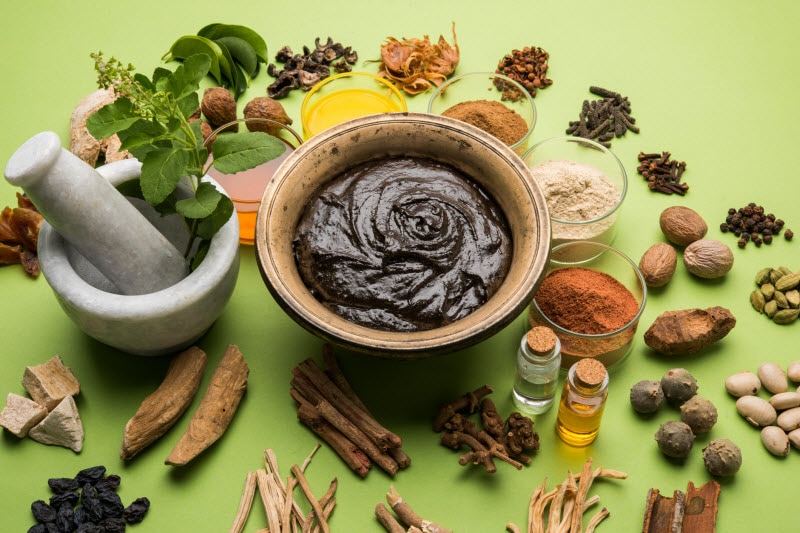Ayurveda, or Ayurvedic medicine, is one of the oldest and most comprehensive healthy-lifestyle systems in the world. It’s a 5,000-year-old method of natural healing that has its origins in the Vedic culture of India. In fact, the name Ayurveda breaks down to mean the science of life (Ayur means life, Veda means science or knowledge).
Ayurveda offers a mind-body approach to health that includes lifestyle practices such as massage, meditation, yoga and diet as well as the use of herbal remedies. At its heart, Ayurveda is designed to nourish your inherent vitality while helping you realize your full human potential. Ultimately, Ayurveda helps us explore—and find—the right balance between our environment, body, mind and spirit.
But in order to find balance, we need to know the nature of the energies that swirl within us—and without. Ayurveda describes five master elements that make up everything within our bodies and everything outside of our bodies: space, air, fire, water and earth. In turn, those five elements form the basis of the three doshas, or constitutions, that govern our way of being in the world.
In addition to changing our lifestyle (sometimes radically), Ayurveda relies on specific herbs to help us come into a better state of balance. While that looks different for each person, there are several herbs that serve as the workhorses of wellbeing. Here is a quick primer of six of the most important Ayurvedic herbs.
Ayurvedic Medicine: Herbs for Beginners
Ashwagandha
Native to dry regions in India, northern Africa and the Middle East, ashwagandha (Withania somnifera or winter cherry) is a stout, plump shrub with yellow flowers and raisin-sized red fruit widely used in Ayurvedic practice. Ashwagandha is an ‘adaptogen,’ a term used to describe herbs that help the body adapt to stress.* The plant’s nutrient-rich roots are steeped into a tea or powdered and added to beverages or supplements to support a wide range of health goals. The ‘ginseng’ of Ayurvedic medicine, ashwagandha is thought to help support physical energy and promote healthy levels of sex hormones.* It also has antioxidant properties that aid in protecting against free radical damage.*
Shatavari
Shatavari (which literally means “a woman who has a hundred husbands”) is highly regarded as an herb for women’s health. Also known as the queen of herbs, shatavari (asparagus) is a climbing plant with tiny white flowers and purple-black berries. The root of the plant is pulverized and the ground powder is used to make teas, tonics or supplements considered adaptogenic—grounding, soothing, and rejuvenating.*
Amla
Amla, also called amalaki or Indian gooseberry, is a tart-tangy, yellowish-green fruit that grows in clusters on the Phyllanthus emblica tree, native to India and the Middle East. Rich in vitamin C and enjoyed as a sour fruit, these tiny treasures are also dried and powdered for use in traditional Ayurvedic health practice. Known as the “nurse herb” because of its strengthening properties, amla is thought to have rejuvenating effects on the body.
Turmeric
Bright yellow-orange with a warm, bitter gingery flavor, turmeric is an ancient spice native to India and Southeast Asia, from the ground root of the tropical Curcuma longa plant. A familiar seasoning for Indian food lovers, turmeric is popular in many Indian dishes, especially curries, sauces and soups. Turmeric contains curcumin, a potent plant compound that’s been widely studied for its health-promoting potential. According to Ayurveda, turmeric supports liver function and is believed to be a rich source of healthful antioxidants.*
Neem
One of the most versatile herbs, neem (Azadirachta indica) is actually a tropical tree: the bark, leaves, twigs and flowers are all blended to create neem powder. Ayurveda considers neem as a superlative purifier and cleanser.
Tulsi
In India, Tulsi (known as Holy Basil) is revered as a sacred plant—many Indians have a living Tulsi plant in their home that they tend to with great respect. In India the herb has been used for thousands of years to support wellness. Tulsi, an adaptogen par excellence, is often used as a refreshing tea that may help support well-being and combat effects of stress.*

